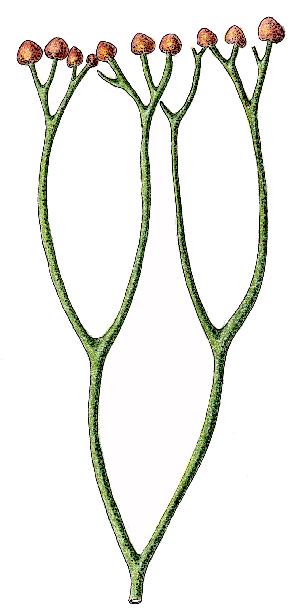
| Palaeos |  |
Tracheophyta |
| Plants | Cooksonia |
| Page Back | Unit Back | Up | Unit Home | Glossary |
| Page Next | Unit Next | Down | Plants | Dendrogram |

The earliest well-known plant, which flourished during the late Silurian and early Devonian is called Cooksonia. It is named after Isabel Cookson, who occupied herself with intensive collecting and describing plant fossils. The little plant was only a few centimeters in height and very simple in structure, in fact it is the most primitive known vascular land plant. It consists of a stem which bifurcated several times, and ended in small spheres (sporangia) in which the spores were formed. It is possible that horizontal growing stems, connected with the soil by root hairs, functioned as roots. It was nevertheless a true vascular plant, with tracheid-resembling internal conducting cells (revealed by fossil microstructure), and already equipped for life in an aerial, terrestrial environment
The earliest fossils of Cooksonia have been found in Middle Silurian Wenlock strata from Tipperary, Ireland. They consist of small bifurcations some centimeters in size. During the latest Silurian Cooksonia becomes more common, and by the early Devonian has been supplanted by other species of land-plants.
Cooksonia has been found widely across Euramerica (fossils are known from Wales, Scotland, Ireland, Czechoslovakia, Kazakhstan, New York, and Ontario) and Siberia, all of which seem to have part of a singly phytogeographical province or biome. Interestingly, the fauna of the northern hemisphere was very different from that of the possibly contemporary or later Barragwanathia fauna of Gondwanaland
Four species are known - Cooksonia pertoni, C. caledonica, C. cambrensis, and C. hemisphaerica. These differ only in minor ways, chiefly in the form and structure of the spore-case, but already Cooksonia includes plants related to the lycophytes (Cooksonia cambrensis). This means that the genus Cooksonia is a paraphyletic grade rather than a monophyletic clade; a group of similar plants that are near to the major evolutionary branching that leads to the Lycophytes (more on grades vs clades). Organisms like Cooksonia give the lie to claims by Christian Creationists that no intermediate forms have ever been found in the fossil record.
| Links |
![]()
![]() Early Land Plants (1) includes some good info on Cooksonia
Early Land Plants (1) includes some good info on Cooksonia
![]() The Oldest land plants - includes
material on Cooksonia
The Oldest land plants - includes
material on Cooksonia
![]()
![]() Cooksonia pertoni - photo of specimen
Cooksonia pertoni - photo of specimen
![]()
![]() Cooksonia pertoni - photo showing sporangia
Cooksonia pertoni - photo showing sporangia
![]() Early Land plants - includes material on Cooksonia
Early Land plants - includes material on Cooksonia
![]() How plants conquered the land - includes info on Cooksonia
How plants conquered the land - includes info on Cooksonia
![]() Megan's Research on the First Land Plants - this is quite cute and easy to follow
Megan's Research on the First Land Plants - this is quite cute and easy to follow
| Page Back | Page Up | Page Top | Page Next |